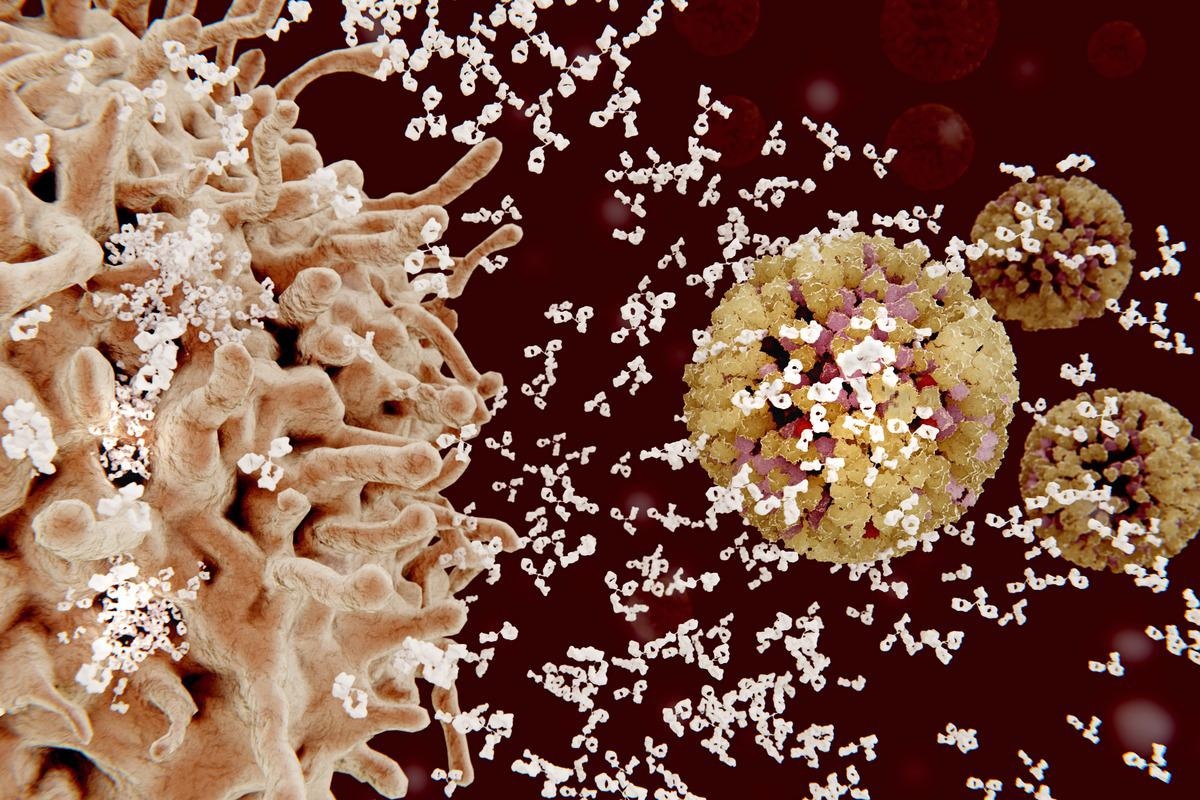Characterization of the baseline SARS-CoV-2 S-reactive B cell repertoire
Severe acute respiratory syndrome coronavirus 2 (SARS-COV-2), the causative agent of coronavirus disease 2019 (COVID-19), spread globally in 2020/2021 and caused mass health and economic crises triggered by costly and expensive lockdowns.
 Study: A public antibody class recognizes a novel S2 epitope exposed on open conformations of SARS-CoV-2 spike. Image Credit: Juan Gaertner/Shutterstock
Study: A public antibody class recognizes a novel S2 epitope exposed on open conformations of SARS-CoV-2 spike. Image Credit: Juan Gaertner/Shutterstock
Mass vaccination schemes inducing neutralizing antibodies against the spike protein allowed some lockdowns to end. However, researchers from the University Of Amsterdam have identified several oddities in unvaccinated individuals' antibody response to the spike protein.
A preprint version of the study is available on the bioRxiv* server while the article undergoes peer review.
The study
The researchers investigated samples from ten individuals who had never been exposed to SARS-CoV-2 or received a vaccine. They interrogated these individuals' baseline spike protein reactive B cell repertoire using a combinatorial B cell staining approach with labeled antigenic probes. This novel method allowed for the simultaneous identification of B cells reactive to six different pathogens in a single sample.
SARS-CoV-2 reactive B cells were then compared to those that recognized pre-encountered antigens, including influenza A hemagglutinin fusion protein, tetanus toxoid, HIV-envelope glycoprotein, and hepatitis C virus envelope protein. The B cells specific for SARS-CoV-2 were present at a relatively high frequency in unexposed individuals, around 10-30 fold higher than other unencountered antigens. The level of anti-spike B cells was more similar to the level seen against previously encountered antigens.
The scientists then analyzed both the naïve and memory subsets of the specific B cells and subdivided them into four populations according to the surface expression of IgD and CD27. These were naive, classical memory, CD27- memory, and unswitched memory.
As expected, there were nearly no naive B cells for previously encountered antigens (~0.001%), but there was a significant amount for the spike protein, around 0.11%. The researchers suggest that this could indicate a de novo B cell response from the naive compartment playing a role in infection with SARS-CoV-2.
For the classical memory compartment, B cells against seasonal infections or against vaccine targets were much more common than those against the spike protein. However, the SARS-CoV-2 spike protein reactive B cells were still seen more often than those against unencountered antigens. The majority of these were IgG+, while B cells that targeted vaccine components were normally IgM+ and those against seasonal infections were IgM-.
SARS-CoV-2 spike protein reactive memory B cells, peripheral blood mononuclear cells (PBMCs) were then stimulated with resiquimod, IL2, and IL-21, allowing the differentiation of memory B cells into plasmablasts.
Then, the Spike protein- reactive Ig secretion could be assessed against a set of control antigens, revealing that high antibody levels were seen against common seasonal infections compared to relatively low levels against SARS-CoV-2, previously unencountered antigens as well as other coronaviruses such as SARS-CoV and MERS-CoV.
However, the reaction against SARS-CoV-2 spike protein was still higher than the other coronaviruses and unencountered antigens. In eighty percent of samples from unexposed individuals, the specific antibodies against SARS-CoV-2 were similar to those against other coronaviruses.
The B cells that were reactive against SARS-CoV-2 were single-cell sorted. The vast majority of these were IgD+/CD27- and belonged to the naive B cell compartment, confirming previous observations. One hundred thirty-two heavy chain sequences paired with 101 light chain sequences were obtained. 101, 20, and 5 of the sequences from the heavy chains came from naive, unswitched, and classical memory B cells, respectively.
In 75% of the donors that had samples taken for single-cell sorting, IGHV1-69 was the most dominant heavy chain gene used by cells reactive against the spike protein, and in the remaining 25%, it was the second most dominant. The IGVK3 family made up 36% of the light chains in the light chain sequence compared to 8% in an unselected naïve repertoire. Considering the pairing of the heavy and light chains, 13% of all pairs were IGHV1-69/IGKV2-11.
Conclusion
The authors highlight that the number of B cells reactive to the SARS-CoV-2 spike protein is much higher than expected, with far more reactivity than other previously unencountered antigens and a significantly increased proportion of naive B cells showing reactivity. There was also an existing pool of memory B cells able to recognize SARS-CoV-2 in unexposed individuals.
The researchers suggest that the significant presence of IGHV1-69/IGKV3-11 antibodies may recognize conserved/aberrant spike protein conformation and argue for further research to investigate whether the generation of these antibodies should be promoted during vaccination.
*Important notice
bioRxiv publishes preliminary scientific reports that are not peer-reviewed and, therefore, should not be regarded as conclusive, guide clinical practice/health-related behavior, or treated as established information
Claireaux, M. et al. (2021) "A public antibody class recognizes a novel S2 epitope exposed on open conformations of SARS-CoV-2 spike". bioRxiv. doi: 10.1101/2021.12.01.470767. https://www.biorxiv.org/content/10.1101/2021.12.01.470767v1
Posted in: Medical Science News | Medical Research News | Disease/Infection News
Tags: Antibodies, Antibody, B Cell, Blood, Cell, Cell Sorting, Coronavirus, Coronavirus Disease COVID-19, Frequency, Gene, Glycoprotein, Hepatitis, Hepatitis C, HIV, Influenza, MERS-CoV, Protein, Research, Respiratory, SARS, SARS-CoV-2, Severe Acute Respiratory, Severe Acute Respiratory Syndrome, Spike Protein, Syndrome, Tetanus, Vaccine, Virus

Written by
Sam Hancock
Sam completed his MSci in Genetics at the University of Nottingham in 2019, fuelled initially by an interest in genetic ageing. As part of his degree, he also investigated the role of rnh genes in originless replication in archaea.
Source: Read Full Article
